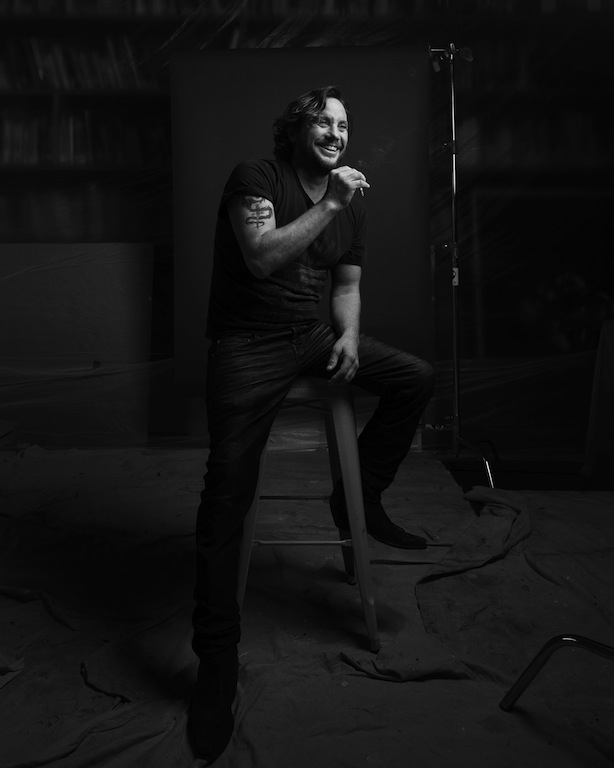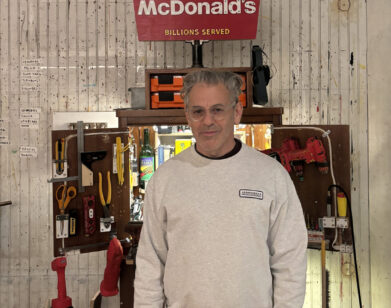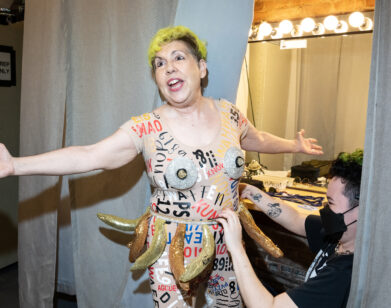Samuel Bayer’s American Image
“I always used to say that, maybe I didn’t become successful as a painter, but my images were seen by lots and lots of people,” muses filmmaker Samuel Bayer over the phone. He is not exaggerating. Between his music videos for Justin Timberlake, The Rolling Stones, Green Day and The Strokes, and his Super Bowl commercials for Chrysler and Budweiser, most Americans are familiar with Bayer’s art, whether they realize it or not.
Trained as a painter, Bayer stormed onto MTV in the early 1990s. His first music video was for Nirvana’s breakout single, “Smells Like Teen Spirit” (1991). By the end of 1992, Bayer had directed music videos for the likes of Ozzy Osbourne, Iron Maiden, The Ramones, Blind Melon, Johnny Lee Hooker, and The Jesus and Mary Chain. Bayer’s videos provided a powerful mix of musicians performing in a smoky haze cut with arresting, often black and white images. Think of Dolores O’Riordan covered in gold paint, tied to a cross, surrounded by gold Cupids with bows and arrows, interspersed with IRA graffiti and dirty children roaming the desolate Belfast streets in The Cranberries’ “Zombie.” Or Billy Corgan surrounded by dust-covered Diamond miners in the Smashing Pumpkin’s “Bullet with Butterfly Wings.” Or Courtney Love, raw after Kurt Cobain’s death, playing acoustic guitar on a striped mattress as a Cobain-resembling child comes into the room in Hole’s “Doll Parts” video. To say that Bayer’s images helped shape the aesthetic of the early ’90s is not a stretch.
Now 48, Bayer has retired from music videos, concentrating instead on commercials, feature films (he made his directorial debut in 2010 and has another film in the works), and photography. His latest exhibition of photography, 16 towering triptychs of nude women and two diptychs of female faces, is currently on show at Ace Gallery in Beverly Hills.
EMMA BROWN: What was the first music video that made you feel like, “Maybe I can do this, too”?
SAMUEL BAYER: I think it was Peter Gabriel, “Shock the Monkey.” Makes my memory kick in. Peter Gabriel’s “Shock the Monkey” is like a Werner Herzog film, it’s just weird.
BROWN: You started out as a painter.
BAYER: Yeah, I went to the School of Visual Arts. I was a painter. I was in New York around the time of Basquiat and Keith Haring and all those guys. That’s originally what I wanted to be, but nobody liked my work. [laughs]
BROWN: Do you still paint?
BAYER: I don’t. I think we all go through times in our lives when we decide, “I’m going to try something else.” I tried filmmaking instead of painting, and I think I enjoyed it more. So I don’t paint anymore.
BROWN: When you started making music videos, did you see it as an entry point into making feature films?
BAYER: You know, I think I was just interested in making money. [laughs] I went from being a starving artist to a guy that was actually getting paid to make artwork, so I was just happy to be getting paid.
[Now] I’ve got a movie in development with the company that did Eternal Sunshine of the Spotless Mind and Winter’s Bone, called Anonymous Content. It’s a really cool script, it’s character driven. I like to call it One Flew Over the Cuckoo’s Nest in an old folks’ home. That will be my next project. That’s what I’m really passionate about.
BROWN: The first music video you directed was Nirvana’s “Smells Like Teen Spirit.” I heard Kurt Cobain was pretty difficult on set. Was that very intimidating?
BAYER: It was actually really exciting. I think the reason I got Nirvana is because it wasn’t exactly a high-profile project in the record company. When I did the video, the things that were at the top of the US charts were M.C. Hammer, Guns N’ Roses, Metallica. I don’t think anybody really thought that this punk band from Seattle was going to sell so many records or become such a cultural phenomenon. I think the reason I got the job is because they were looking for hungry artists to maybe cut their teeth on it and do something different. Even though I thought the band was amazing, I had no idea it was going to blow up the way it did.
BROWN: When you sign on to make a music video, does the artist present their idea to you, or do you listen to the song and present your ideas to the artist? How involved is the artist in deciding what they want in their music video?
BAYER: When you actually get successful, if you became a recognized director, people would let you come up with an idea for a video and they would let you do it. At the time, Kurt had an idea to do a rebellion at a high school. He wanted it to look like Rock ‘n’ Roll High School (1979) by the Ramones, mixed with a movie that Matt Dillon did called Over the Edge (1979). I heard him say that and came up with something very dark and gritty. Most of the time, when you get some recognition, you’re allowed to come up with the ideas. [“Smells Like Teen Spirit”] was much more my interpretation of what Kurt Cobain’s idea was.
BROWN: When did you start getting recognized? Was there a certain moment when things changed for you in terms of how much creative control you were given?
BAYER: After Nirvana came out, I did a video for Blind Melon called “No Rain” that was kind of the antithesis of Nirvana. If Nirvana was kind of dark and gritty, then Blind Melon was The Wizard of Oz. It was like beautiful Technicolor—really pretty to look at—and left you with a really warm feeling in your heart. After I did those two projects, things seemed to really take off for me; I was offered a lot of work. The ’90s were a fun time for me—I got to work with all my heroes. I got to work with David Bowie and the Rolling Stones and John Lee Hooker before he died. I was like a kid in a candy store.
I think music can define our lives. Working with Mick [Jagger] and Keith [Richards] and talking to the guys that wrote the soundtrack of my youth was kind of cool. It’s interesting when we meet our heroes; sometimes they really let us down, and sometimes we realize that they’re just other human beings like us, with the same drama and fears and everything else going into their lives. I’ve worked with lots of people at different stages of their careers—going up, going down. Some people I’ve worked with I would never want to work with again, and some people would probably say they never want to work with me again. But all in all, it was definitely cool. When I worked with Bowie [on “The Heart’s Filthy Lesson“], Interview magazine came down to the set and printed a bunch of stuff from the shoot. That was one of my favorite people. Working with Bowie was amazing. I wish they were all like that.
BROWN: Is there anyone aside from David Bowie that you’d really want to work with again?
BAYER: I never saw anything like what happened with Nirvana. It’s been a long, long time, but I would’ve liked to work with Kurt Cobain again.
BROWN: You worked with Courtney Love on Hole’s “Doll Parts” video.
BAYER: Yeah, I worked with Courtney six months after Kurt committed suicide, and that was a very heavy experience.
BROWN: Especially with that song, which is about him.
BAYER: Yeah, and we cast a little boy to play a young Kurt Cobain. Just knowing he was dead, and his daughter was there. It was very sobering and intense.
BROWN: You’ve mentioned that you no longer direct a lot of music videos, but you made “Payphone” (2012) with Maroon 5 fairly recently. What made you decide to take on that project?
BAYER: I think it was the fact that I got on the phone with Adam Levine and we talked about using machine guns, maybe a car chase and a hot model. How can I say no to that? That was just fun, I really loved him. We really went big; we talked about doing something that felt like a movie and not like a music video. I think Adam would make a great action star. He was very good.
BROWN: Do music videos have bigger budgets now than when you started in the early ’90s?
BAYER: I think the budgets have dropped dramatically. For me, doing music videos is like going to film school—I learned on set. If I was a young director starting off, there’s so many tools at your disposal now to do things relatively inexpensively that it’s a great time to learn your chops and do some cool music videos. If I started all over again, I’d still be doing music videos, I’d just be doing them very differently. With what you’re able to do on your home computer, as far as effects go; with how you can shoot film in HD now, and make it really beautiful. It’s very difficult for me to do them now, but for young kids out there that love music and want to tackle a different art form—and I do think music video is an art form—that’s a very cool thing to do.
BROWN: Do you ever shoot in HD?
BAYER: I just started shooting in HD pretty religiously about six months ago. The technology has changed so beautifully. I shot the Maroon 5 video in HD, and I think it looks like film. I’ve changed with the times, too. I hope film never dies; I will continue to shoot on it, but I do shoot HD now.
BROWN: What aspects of film do you particularly value and want to recreate in HD?
BAYER: One of my favorite music videos I did is this video for Garbage called “Stupid Girl,” where I actually took the film negative and put it in my bathtub, stuck it in the ocean, burnt cigarettes on it. I did the same thing with Green Day’s “Boulevard of Broken Dreams.” It’s film; it’s organic, it’s tactile, and you can touch it. There are things that you could do with film that you could never do with HD. There’s a warmth and an organic quality—almost a handmade quality—that goes into film. Film will always have a bit more of a humanistic feeling to it.
BROWN: Do you need to like the music of the artists you’re directing, or does it not matter?
BAYER: No, I really gotta like it, man. It makes a big difference to like the music. I really did like the Maroon 5 song. I did a handful of music videos in the past decade. I really liked Green Day a lot, and really enjoyed working with them. Did a great song with Justin Timberlake, “What Goes Around Comes Around,” and we put Scarlett Johansson in the video and I really loved the song. You’ve got to dig the music. You’ve got to—or why do it?
BROWN: And you had Angelina Jolie in your Rolling Stone video, “Anybody Seen My Baby?“
BAYER: Yeah, I just read an article that Mick was chasing Angelina around for three years after that video. I thought that was really funny. It was just one of the cool things about all the years I spent doing it, I got to put the 22-year-old Angelina Jolie in a music video. If you talk to some New Yorkers, they might remember a girl in her underwear running down the street on Fifth Avenue, and that was Angelina Jolie.
BROWN: Do you play any instruments? Did you have a band as a teenager?
BAYER: I like posing with a guitar better than I can play the guitar, so I think I found the right field. [But] I’ve spent enough time with rock stars to tell you that the best thing in life to be is a rock star. [laughs]
BROWN: How does your approach to commercials differ from your approach to music videos?
BAYER: They’re very different disciplines. Music videos are so incredibly relevant, but I don’t think they’re relevant on broadcast television anymore. I think they’re much more about the power of the Internet. The stakes in advertising is a very different game. There’s a lot of money involved and a lot of pressure. I miss the freedom and the rock-‘n’-roll spirit of doing music videos, but I did this commercial for the Super Bowl with Eminem and Chrysler called “Born of Fire,” which won an Emmy and a Gold Lion at Cannes. It was sort of a beautiful fusion of advertising and music video. It was a really cool phenomenon that doesn’t happen very often.
BROWN: I also wanted to ask you about your gallery show in LA. How did you decide which girl should be triptychs and who should be diptychs?
BAYER: [laughs] Some girls have faces that are perfect for diptychs and some girls have bodies that are perfect for triptychs. It took me five years to launch this whole show. We treated it like a feature film—we did casting sessions. That’s the way I had to find my girls. There’s a very deliberate look that I’m looking for to be a triptych or a diptych. It’s not necessarily the most beautiful girl in the room; it’s about being beautiful on the inside too.
BROWN: But they are all beautiful on the outside.
BAYER: They’re all pretty. But I was looking for an inner spirit that transcends the film negative. It’s interesting you talk about beauty, because really what this show is somewhat about is about stripping away—all the women are filmed without clothing, without makeup, hair. There’s a real kind of nakedness to this show—not just physically but also emotionally. I sound pretentious saying all this crap, but it’s true.
What I think came from my years as a painter, I love Botticelli’s The Birth of Venus or Raphael’s work with nudes. I’m very influenced by what Helmut Newton did with women. There is something about the classic female form in an idealized fashion, and I really wanted to pay homage to. There is certainly a physical beauty that was important to put on the film negative and capture, and also part of how the human form has been idealized through hundreds of years of art history. It was important for me to make that connection.
BROWN: How did the original idea begin five years ago?
BAYER: I think I drew a picture of a girl on a napkin at a bar and started folding the napkin up. I started thinking about dissecting the human form: these could make singularly beautiful images—if it was torso or the hips or her head—and they could be standalone images. But if I put them together, it could also form a pretty piece of work. I think that’s where all cool ideas come from—a happy accident. Then it was all about executing the idea. If you had told me that it would take five years to do the images, I might’ve crumpled up the napkin and said just forget it. But it was something I got really passionate about doing.
BROWN: Are you ever going to rearrange them?
BAYER: [laughs] If people buy the photographs and rearrange them, they can. I think that’ll be up to somebody else. Nobody’s ever asked me that.
BROWN: I heard that one of the billboards for your show was stolen.
BAYER: Yeah. When I was told the billboard got stolen, it made me feel like I really arrived; things are pretty cool and happening if you can get a billboard to get stolen. I was kind of shocked, [but] it also made me smile. I think it’s pretty funny.
I remember, when I went to the School of Visual Arts, Keith Haring had tagged the lockers up in the lunchroom. We all came in one day and all the lockers were missing, somebody came into the school and took them. You want people to want your stuff. And if they’ve got to steal it, hey, that’s cool. It’s nice to be wanted.
SAMUEL BAYER’S “DIPTYCHS AND TRIPTYCHS” ARE ON VIEW AT ACE GALLERY BEVERLY HILLS THROUGH APRIL 27. FOR MORE INFORMATION VISIT BAYER’S WEBSITE.







